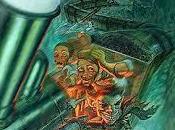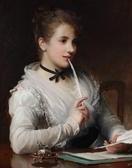Essere amati profondamente da qualcuno dà forza. Amare profondamente qualcuno dà coraggio.Lao Tzu (filosofo cinese, 500 a.C. circa)

Corfù, 1861 ( con lei Houseguard, sconosciuto il nome dell'altro cane che dorme ai suoi piedi)

Un'anima inquieta e solitaria che, interdetta nel comunicare la profondità e la complessità del proprio essere a chi non ha il dono, raro, della sua stessa sensibilità, trova rispondenza nell'animo degli animali e comunica con gioia e trasporto con i cavalli di cui, in gran numero, si circonda, ( ve ne parlai qui ) e con i cani, anch'essi spesso presenti a corte intorno a lei - con non altrettanto piacere da parte dell'arciduchessa Sofia - cani di razze differenti che spesso voleva comparissero nelle fotografie che le venivano fatte, quasi come se di lei fossero parte, parte di quell'angelica romantica creatura, sospesa tra sogno e realtà, che altro era rispetto all'Imperatrice che vediamo comparire nei ritratti ufficiali, la statuaria, solenne consorte dell'Imperatore d'Austria Ungheria.
Quanti sono i contenuti che non ammettono verbalizzazione alcuna, ma possono solamente essere percepiti ... è questa non una pecca, bensì un dono, prezioso, che ancora ci tiene uniti al mondo animale, forse oggi più ancora di allora difficile da mantenere vivo, il cui prestigio non ha paragone e prezzo alcuno ... e questo Elisabetta bene lo sapeva e lo comprendeva, e cercò, con successo, di trasmetterlo anche alla propria prole.
Puoi conoscere il cuore di un uomo già dal modo in cui egli tratta gli animali. Immanuel Kant (filosofo tedesco, 1724 - 1804)

l'Imperatrice con il suo barboncino Platon
L'Imperatrice durante la sua seppur breve vita ebbe molti cani, tra i più piccoli vi fu Platon all'inizio degli anni sessanta, il barboncino nero con il quale sembra dialogare e che persino in un'occasione riesce a strapparle un seppur debole sorriso ( foto scattate da Ludwig Angerer nel 1862 )


ma con il tempo sempre più si fece conquistare da quelli di grossa taglia; il primo che ebbe un posto speciale nel suo cuore fu uno splendido lupo irlandese che ella chiamo Houseguard

Houseguard by Carl Reichert, 1873
con il quale si fece ritrarre nella celebre serie scattata tra il 1866 ed il 1867 da Emil Rabending, scatti che sono per me, per molteplici ragioni, tra i più amati





... ebbene sì, spesso i suoi cani le 'facevano sbocciare' quel sorriso che raramente ornava il volto di questo delicato, 'pallido fiore sotto l'uragano'1 ..
Anche se probabilmente il più celebre rimane Shadow, l'alano nero con cui condivise il dolore generato dalla tragedia di Mayerling

e che realmente, in quei giorni così bui, era divenuto l'ombra di questa 'eroina del sogno' 2 per descriverla con le parole di D'Annunzio, di questa 'fanciulla di giglio, non nata per le pene del mondo' 3
L'anima ha dei momenti superiori che la colgono - sola - quando amici occasioni della terrasi sono ritirati senza scampo -
o quand'ella è salita di sua forza
a troppo ardite cimeper guardare più in basso, a qualcos'altroche non sia quella nuova onnipotenza -Questo mortale annullamentoè raro - ma ha la vaghezza di un'apparizioneal servizio dell'aria - Lo svelamento che l'eternitàconcede a pochi eletti -la smisurata formadell'immortalità-Emily Dickinson, 306
Ma vediamo insieme i suoi 'compagni', almeno quelli che ci sono accessibili dal web, tutti dipinti dal pittore della Vienna Vittoriana Carl Reichert (1836 - 1918) particolarmente capace e perciò apprezzato per le sue rappresentazioni del mondo animale, soprattutto cani e gatti

Hamlet

Roma

Brave

Qui la piccola Marie Valerie ritratta da Franz Schrotzberg con un Leonberger, con ogni probabilità si tratta di Brave

Qui ancora con Brave in una fotografia di Victor Angerer

Foto scattata alle soglie della Kaiservilla di Bad Ischl dove uno dei tanti 'badanti' tiene due cani dell'Imperatrice, sicuramente Shadow in piedi e Mohamed coricato

Fanton e Morfy
Per questa sue caratteristiche che ben conosciamo e che ce la rendono ancor oggi così amabile, l'Imperatrice fu indotta sempre più ad isolarsi e a condurre una vita riservata e solinga, ma, con le parole di Erich Fromm, tratte da L'arte di amare, vi lascio a riflettere ....
Scriveva questi negli anni '50
Paradossalmente, la capacità di stare soli è la condizione prima per la capacità d'amare. 5 ed ancora
Dare è la più alta espressione di potenza. Nello stesso atto di dare, io provo la mia forza, la mia ricchezza, il mio potere. Questa sensazione di vitalità e di potenza mi riempie di gioia. Mi sento traboccante di vita e di felicità. Dare dà più gioia che ricevere, non perché è privazione, ma perché in quell'atto mi sento vivo.6
Erich Fromm (sociologo e psicoanalista tedesco, 1900 - 1980)

Carl Reichert, Besuch im Pferdestall, 1918
Non è stato questo un argomento di facile trattazione perché poco si trova a questo proposito anche nei testi autobiografici, ma ho comunque voluto farvi dono di tutto quanto è di mia conoscenza a tale proposito, per completare questo puzzle che è la complessa, magnificamente misteriosa ed affascinante personalità di questa Sovrana figura.
Vi giunge quindi, arrivati qui, il mio sempre più affettuoso e riconoscente saluto che vi accompagna fino al nostro prossimo incontro,
a presto ♥


Bibliografia:
Hellmut Andics, Die Frauen der Habsburger, WILHELM HEYNE VERLAG, München, 1995Elisabetta d'Austria, Diario poetico, MGS PRESS SAS, 1998
ELISABETTA D'AUSTRIA NEI FOGLI DI DIARIO DI COSTANTIN CHRISTOMANOS, Adelphi edizioni S.p.A., Milano, 1989
Maria Valeria d'Asburgo, La prediletta - Il diario della figlia di Sissi, a cura di Martha e Horst Schad, traduzione di Flavia Floradini, MGS PRESS, 2001
Conte Egon Cesar Corti, L'imperatrice Elisabetta, Mondadori, Milano, 1937
Gabriele D'Annunzio, LA VIRTU' DEL FERRO, in «Il Mattino», 29-30 settembre 1898, riportato inGabriele D’Annunzio, Scritti giornalistici, Meridiani, Mondadori, vol.II, ora anche sul web nella sezione ANTOLOGIA del sito UNA RAPIDA EBBREZZA, curato da Massimo Sannelli e Vincenzo Laura
( http://unarapidaebbrezza.blogspot.it/2011/12/dannunzio.html )Emily Dickinson, EMILY DICKINSON TUTTE LE POESIE, Arnoldo Mondadori Editore, Milano, 1997,
Eric Fromm, L'arte di Amare, traduzione di Marilena Damiani, Mondadori, Milano, 1996
Brigitte Hamann, Elisabeth. Kaiserin wieder Willen, Amalthea Verlag, Wien, München, 1982
Brigitte Hamann, (a cura di), ELISABETH Bilder einer Kaiserin, Amalthea Verlag, 1998
Gabriele Praschl - Bichler, L'Imperatrice Elisabetta, Longanesi & C., Milano, 1997Oscar Wilde, Poesie, Lorenzo Barbera Editore, Srl, Siena, 2006
Citazioni:
1 - Oscar Wilde, LA BELLA DONNA DELLA MIA MENTE in Poesie, Lorenzo Barbera Editore, Srl, Siena, 2006, pag.67
2 - La virtù del ferro, in «Il Mattino», 29-30 settembre 1898, riportato inGabriele D’Annunzio, Scritti giornalistici, Meridiani, Mondadori, vol.II, ora anche sul web nella sezione ANTOLOGIA del sito UNA RAPIDA EBBREZZA, curato da Massimo Sannelli e Vincenzo Laura
( http://unarapidaebbrezza.blogspot.it/2011/12/dannunzio.html )3 - Oscar Wilde, MADONNA MIA in Poesie, Lorenzo Barbera Editore, Srl, Siena, 2006, pag. 40
4 - Emily Dickinson, EMILY DICKINSON TUTTE LE POESIE, Arnoldo Mondadori Editore, Milano, 1997, 306, pag. 330
5 - Eric Fromm, L'arte di Amare,traduzione di Marilena Damiani, Mondadori, Milano, 1996, pag. 119
6 - Eric Fromm, L'arte di Amare, op. cit., pag. 34

The Empress' dogs.
Being deeply loved by someone gives you strength. To love someone deeply gives you courage.
Lao Tzu (Chinese philosopher, 500 a.C. circa)
- picture 1 - Corfu, 1861 (with her Houseguard, unknown the name of the dog sleeping at her feet)
- picture 2
A restless and solitary soul, to which was forbidden to communicate the depth and complexity of Her soul being so few those who have the rae gift of Her same sensibility, finds correspondence in the soul of animals and communicates with joy and transport with horses which, in large numbers, surrounds Her, (here I already wrote about it) and with dogs, which are also often present at Court around her - not with the same pleasure from Archduchess Sofia - dogs of different breeds that often she wanted by Her side in the photographs that were made Her, almost as if they were part of Her, part of that angelic romantic creature, suspended between dream and reality, who was someone else compared with the Empress we see appearing in official portraits, the statuary, solemn consort of the Emperor of Austria Hungary.How many are the contents that don't admit any verbalization, but can only be perceived ... this is not a flaw, but rather a gift, a precious precious, that still binds us to the animal world, perhaps now more even then difficult to keep alive, the prestige of which has no comparison and no money ... and that Elisabeth knew and understood well, and tried, successfully, to transmit also to her offspring.
You know the heart of a man already by the way he treats animals.Immanuel Kant (German philosopher, 1724-1804)
- picture 3 - The Empress with her poodle Platon
The Empress during her short life had many dogs, among the smallest there was Platon in the early sixties, the black poodle with which she seems to talk to, and, in one occasion, even manages to snatch Her an albeit weak smile (photos by Ludwig Angerer in 1862)
- picture 4
- picture 5
but over time She became increasingly conquered by those of larger size; the first which had a special place in Her heart was a wonderful Irish wolfhound She call Houseguard
- picture 6 - Houseguard by Carl Reichert, 1873
with which She was portrayed in the famous series taken between 1866 and 1867 by Emil Rabending, shots that are to me, for several reasons, the most beloved
- picture 7
- picture 8
- picture 9
- picture 10
- picture 11
... Yes, often Her dogs made flourish that smile that rarely adorned the face of this delicate, 'pale flower under the hurricane'1 ...
Although probably the most famous remains Shadow, the black Great Dane with whom She shared the pain generated by the tragedy of Mayerling
- picture 12
and that really, in those such dark days, had truly become the shadow of this' dream heroine '2 to describe Her with D'Annunzio's words, this' lily-girl, not born for the pains of this world of ours'3
The Soul's Superior instantsOccur to Her—alone—When friend—and Earth's occasionHave infinite withdrawn—
Or She—Herself—ascendedTo too remote a HeightFor lower RecognitionThan Her Omnipotent—This Mortal AbolitionIs seldom—but as fairAs Apparition—subjectTo Autocratic Air—Eternity's disclosureTo favorites—a few—Of the Colossal substanceOf Immortality
Emily Dickinson, 306 4
But let's see Her 'mates', at least those that are accessible from the web, all painted by the painter of the Victorian Vienna Carl Reichert (1836 - 1918) who was particularly capable and so appreciated for his representation of the animal world, especially dogs and cats
- picture 13 - Hamlet
- picture 14 - Roma
- picture 15 - Brave
- picture 16 - Here the little Marie Valerie is portrayed by Franz Schrotzberg with a Leonberger, probably he's Brave
- picture 17 - Here with Brave again in a photograph by Victor Angerer
- picture 18 - Photograph taken just outside the Kaiservilla in Bad Ischl, where one of the several 'Nannies' holds two of the Empress' dogs, definitely Shadow standing and Mohamed lying.
- picture 19 - Fanton andMorfy
Because of these characteristics that we well know and which today make her so lovable more and more, the Empress was increasingly driven to isolate herself and to lead a private and solitary life, but, with the words of Erich Fromm, taken from "The Art of Loving" I leave you to ponder ....
He wrote in the 1950s
Paradoxically, the ability to be alone is the first condition for the ability to love. 5 and still
Giving is the highest expression of power. In the same act of giving, I feel my strength, my wealth, my power. This feeling of vitality and potency fills me with joy. I feel full of life and happiness. Giving gives more joy than to receive, because it is not deprivation, but because in that act I feel alive. 6
Erich Fromm (German sociologist and psychoanalyst, 1900-1980)
- picture 20 - Carl Reichert, Besuch im Pferdestall, 1918
It was not easy to deal with this topic because we can find so little about it even in the autobiographical texts, but I wanted to make you this gift, to let you know everything I know about it, to complete this puzzle that is the complex, and magnificently mysterious and fascinating personality of this Sovereign Lady.
So, arrived here, my most affectionate and grateful greeting comes to you and will accompany you until we'll meet again,
see you soon ♥


Bibliography:
Hellmut Andics, Die Frauen der Habsburger, WILHELM HEYNE VERLAG, München, 1995Elisabetta d'Austria, Diario poetico, MGS PRESS SAS, 1998
ELISABETTA D'AUSTRIA NEI FOGLI DI DIARIO DI COSTANTIN CHRISTOMANOS, Adelphi edizioni S.p.A., Milano, 1989
Maria Valeria d'Asburgo, La prediletta - Il diario della figlia di Sissi, a cura di Martha e Horst Schad, traduzione di Flavia Floradini, MGS PRESS, 2001
Conte Egon Cesar Corti, L'imperatrice Elisabetta, Mondadori, Milano, 1937
Gabriele D'Annunzio, LA VIRTU' DEL FERRO, La virtù del ferro, in «Il Mattino», 29-30 settembre 1898, collected in Gabriele D’Annunzio, Scritti giornalistici, Meridiani, Mondadori, vol.II, now also on the web in the section ANTOLOGIA of the site UNA RAPIDA EBBREZZA edited by Massimo Sannelli and Vincenzo Laura
( http://unarapidaebbrezza.blogspot.it/2011/12/dannunzio.html )Emily Dickinson, EMILY DICKINSON TUTTE LE POESIE, Arnoldo Mondadori Editore, Milano, 1997,
Eric Fromm, L'arte di Amare, traduzione di Marilena Damiani, Mondadori, Milano, 1996
Brigitte Hamann, Elisabeth. Kaiserin wieder Willen, Amalthea Verlag, Wien, München, 1982
Brigitte Hamann, (a cura di), ELISABETH Bilder einer Kaiserin, Amalthea Verlag, 1998
Gabriele Praschl - Bichler, L'Imperatrice Elisabetta, Longanesi & C., Milano, 1997Oscar Wilde, Poesie, Lorenzo Barbera Editore, Srl, Siena, 2006
Quotations:
1 - Oscar Wilde, LA BELLA DONNA DELLA MIA MENTE in Poesie, Lorenzo Barbera Editore, Srl, Siena, 2006, page 67
2 -.from the article La virtù del ferro, in «Il Mattino», 29-30 settembre 1898, collected in Gabriele D’Annunzio, Scritti giornalistici, Meridiani, Mondadori, vol.II, now also on the web in the section ANTOLOGIA of the site UNA RAPIDA EBBREZZA edited by Massimo Sannelli and Vincenzo Laura
( http://unarapidaebbrezza.blogspot.it/2011/12/dannunzio.html )3 - Oscar Wilde, MADONNA MIA in Poesie, Lorenzo Barbera Editore, Srl, Siena, 2006, page 40
4 - Emily Dickinson, EMILY DICKINSON TUTTE LE POESIE, Arnoldo Mondadori Editore, Milano, 1997, 306, page 330
5 - Eric Fromm, L'arte di Amare,traduzione di Marilena Damiani, Mondadori, Milano, 1996, page 119
6 - Eric Fromm, L'arte di Amare, op. cit., page 34This post is linked up to the lovely blog

http://strangersandpilgrimsonearth.blogspot.com/2015/03/the-art-of-home-making-mondays-please_23.html






